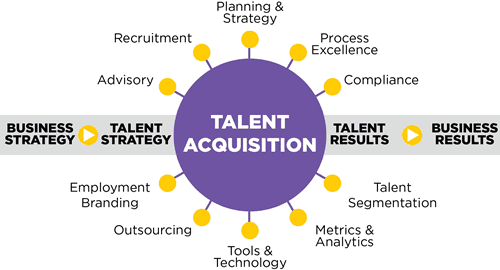What is Talent Acquisition?
In today’s highly competitive labor market, top firms across industry verticals compete fiercely to attract and retain top-performing talent. As organizations undergo rapid digital transformation, there is a constant need to acquire talent with cutting-edge skill sets that can be leveraged to propel change and develop new capabilities.
Talent acquisition is the strategic process of identifying quality candidates to fill a job role, choosing the right candidate for a given role in the organization, hiring that person and inducting them into the company with a comprehensive onboarding process.
Talent acquisition begins with the assessment of a business need to acquire skilled labor for a given role or with a specified skill set. Depending on the size of the organization, responsibility for talent acquisition may fall to a talent acquisition manager, a team of talent acquisition specialists within an HR department or a dedicated talent acquisition department.

Talent Acquisition vs Recruitment - What's the Difference?
Talent acquisition and recruitment ultimately mean the same thing: we want to attract the best possible workers with the best skills and experience to work for our organizations. While the two terms are sometimes used interchangeably, in practice, they can look very different.
Recruiters can operate as part of a corporation or part of an agency. In the corporate model, recruiters work for a single corporation to fill vacant roles with the organization. In the agency model, external recruiting agency contracts with a corporation to fill vacant roles in exchange for a cash payment or a portion of the worker’s salary. Recruiters are most successful when they place the highest volume of candidates in new roles in the shortest amount of time.
Talent acquisition is an emerging function and department that plays a more strategic role within the organization. Talent acquisition experts and specialists take a long-term approach to sourcing and securing talent that will meet the firm’s labor needs. Talent acquisition specialists play a role in corporate succession planning – they work to anticipate how the firm’s labor needs will change in the future, including changes in C-level executive staff, and help to line up replacements in advance. This helps to maintain business continuity during periods of staff turnover.
Of course, talent acquisition does include an element of recruitment. Talent acquisition experts may design or participate in corporate branding initiatives, or help to craft corporate literature and other messaging about the organization’s hiring approach. Ultimately, however, talent acquisition goes beyond recruitment and includes many more aspects of the overall talent management process.

Six Stages of Talent Acquisition
The primary goal of talent acquisition is to ensure that the organization has stable, long-term access to the human resources that are necessary for it to carry out its operations. The process of talent acquisition can be summarized in six stages.
Stage One: Sourcing and Lead Generation
The first step to effective talent acquisition is candidate sourcing and lead generation. Talent acquisition specialists most generate a flow of qualified candidates that may be interested in applying for roles within the organization. The goal is to find, qualify and maintain contact with a network of exceptional candidates, some of whom may wish to apply for a vacant role at the organization in the future.
Talent can be sourced through many different channels and the most skilled talent acquisition professionals understand the benefits of leveraging a multi-channel search for candidates. Popular channels include:
- Social platforms (LinkedIn)
- Job posting websites
- Internal referrals
- Industry networking events
- Colleges and universities
- Online communities
- Professional associations
Talent sourcing is an opportunity to get creative and track down your ideal candidate wherever they are most likely to be found.
Stage Two: Recruitment
Recruitment describes the process of turning a prospective candidate into a job applicant. For a professional recruiter, the end goal is to get the applicant hired at the target organization and set them up for success so they stay for as long as possible. The need for recruitment begins when a job role becomes available and a talent manager reaches out to their contacts in search of a suitable applicant.
Stage Three: Interview and Assessment
Following the successful recruitment of new job applicants for a given role, the next step in the talent acquisition process is to interview and assess each candidate to determine their suitability for the given role. Organizations employ a range of tactics for job interviews, including straight-forward get-to-know-you questioning, behavior-response questions, logic puzzles or reasoning tests, hypothetical questions and a range of other techniques to learn more about applicants and how they think.
The ultimate goal of the interview process is to determine whether a candidate would perform well in a given role and to anticipate any risks or negative outcomes that could result from hiring them.
Stage Four: Reference Verification
Following the completion of the interview phase, talent acquisition managers may conduct reference verification. This entails placing calls to previous workplaces and professional contacts of each candidate to verify their identity and experience.
Stage Five: Selection and Hiring
After all of the candidates have been interviewed and the field has been narrowed through reference verification, the next step is to select the best candidate for the role and make a job offer.
Stage Six: Onboarding and Training
The final stage of talent acquisition happens after an applicant accepts the job offer and is hired by the organization. Employee onboarding can range in length from a couple of weeks to the first six months. The purpose of employee on-boarding and training is to help new employees integrate into the company culture, improve new employee retention and to get new staff members to start being productive and contributing to projects.

Three Important Talent Acquisition Tips
Each organization’s future rests on its ability to attract and retain the best talent that can help it innovate and achieve the next level of operational excellence and business success. Talent acquisition managers that understand their unique role in supporting enterprise objectives follow these three best practices to attract the best available talent to their organizations.
Build a Candidate Pipeline
The candidate pipeline is the most important factor that sets talent acquisition specialists apart from recruiters. Recruiting is reactive: a role in the company becomes vacant, a recruiter finds someone to fill the role. Talent acquisition must be proactive to shorten hiring times and satisfy the needs of the business. Even when no roles are available, the best talent managers continue to network and connect with prospective hires that might be interested in a role in the future.
Optimize the Candidate Experience
Candidate experience is a hot topic in talent acquisition. The candidate experience consists of all of the interactions between your organization and a prospective candidate as they move through the hiring process. Talent acquisition manager who wishes to attract the best employees should design an effective candidate experience, including making it quick, easy and convenient to apply for roles. Clear, consistent and timely communication can also help to provide a seamless and pleasant experience for candidates moving through the hiring process.
Don’t Underestimate Onboarding
Without an effective onboarding process, all of your talent acquisition efforts will be wasted. An effective onboarding process reduces employee anxiety, prevents rapid staff turnover and results in new employees becoming productive more quickly. Hiring new staff without a clearly defined onboarding process is like trying to fill a cup with a hole in it. An effective onboarding process includes:
- Role-specific training and education
- Goal setting and managing expectations
- One-on-one mentoring
- Meeting team members
- Connecting the employee with resources in the organization
- Basic orientation
- Any legally mandated training or paperwork
